At the end of a long tree-lined lane stands a magnificent château. It’s been called one of the most romantic places in the Bordeaux wine region. It’s Château Guiraud, an 1855 Premier Cru Classé estate in the Sauternes appellation and it’s the very first châteaux among the 1855 first growths to be certified organic. The 128 hectare estate makes you feel miles away from the rest of the world as honeybees buzz from flower to flower, birds sing a song as you stroll under the canopy of the plane trees and the sweet scents of Sauternes fill the air. It’s also a château where gastronomic experiences are enhanced by the aromas of the pineapple, apricots and honey of truly exceptional Sauternes wines.
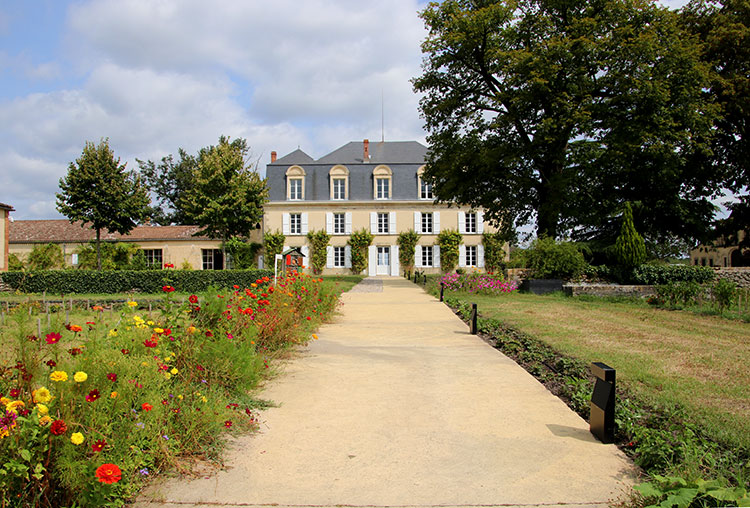
The History of Château Guiraud
Once a farm which we can still see some of the original parts of like the pigeonnier that dates from the 15th century, the estate was originally known as the noble house of Bayle and was owned by the Mons de Saint Poly Family. In 1766 a Bordeaux négociant named Pierre Guiraud purchased the estate and expanded it with the house and Protestant chapel, giving it the name Château Guiraud. Over 80 years three generations of the Guiraud family led the wine making activities at Château Guiraud to the prestige the estate has today, including its classification as a 1er Grand Cru Classe Sauternes in 1855.
Since its founding, Château Guiraud’s wines have bore a black and gold label as a nod to the Guiraud family’s Protestant and Republican values. The label, which still adheres to the exact color code of when Château Guiraud was founded, is one of the oldest labels of Bordeaux. At the time that Pierre Guiraud went against tradition with his choice of the label and font, he was considered very modern and a leader in the evolution of Bordeaux wines. From the very beginning, it seemed Château Guiraud strived to do things just a bit differently.
The château has been owned by a group of four friends since 2006: Robert Peugeot (of the Peugeot car family) and three wine makers: Olivier Bernard (of Domaine de Chevalier), Stephan Von Neipperg (of Château Canon La Gaffelière) and Xavier Planty. Xavier Planty has been the manager, wine maker and cellar master of Château Guiraud since 1986. In another forward thinking gamble by the château, he decided he was tired of chemically treating the vines and started experimenting with organic farming on small plots in 1996.
Those efforts took 15 years, but the gamble paid off when Château Guiraud became the first 1855 Classified First Growth to be certified organic and was awarded with the Agriculture Biologique (AB) farming logo in 2011. With 100 hectares of vineyards, this was no small feat.
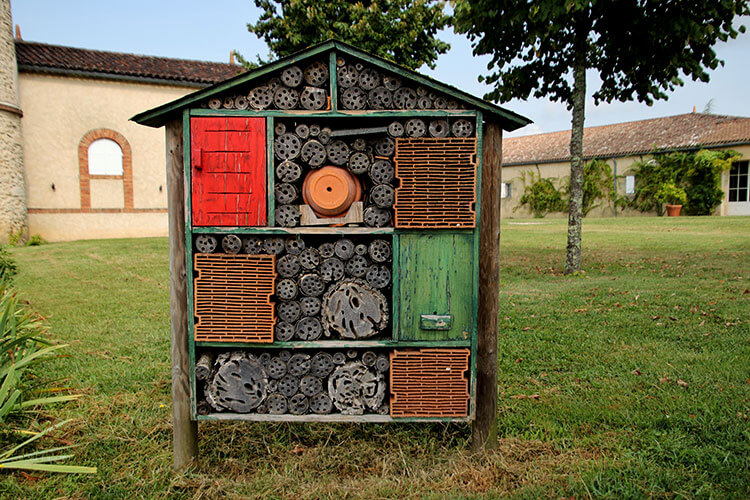
The Visit at Château Guiraud
Very proud of the organic certification and innovative efforts, a visit to Château Guiraud begins outside with a look at two of their insect hotels located around the organic gardens just in front of the main house. In 2010 a census counted 635 different species of insects on the estate, which is more than three times as many typically found on a Bordeaux vineyard. But there’s no reason to get the creepy-crawlies.
The insect hotels, the 12 kilometers of hedges planted around the estate, the pools, the bee hives and the vines themselves are all havens for the bugs that are essential to keeping Château Guiraud pest free. Thanks to all the bugs, spiders and bees, Château Guiraud has been totally insecticide free since 2004.
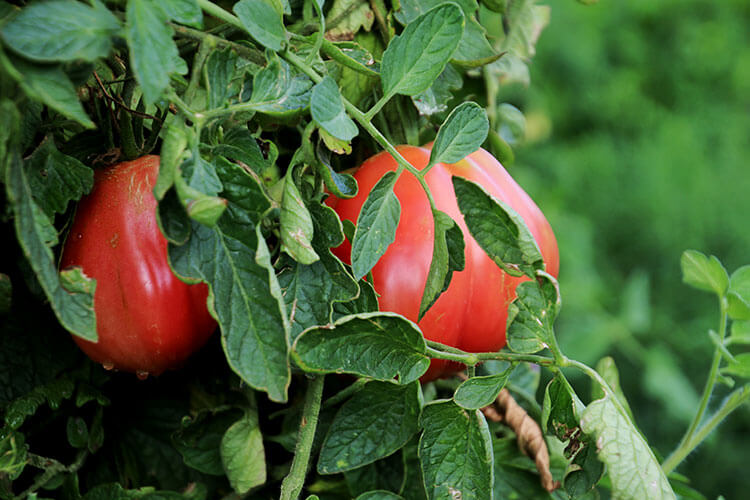
Depending on the time of year you’re visiting, you’ll see everything from peppers to pumpkins in the organic garden. You might notice that there are loads of tomatoes – in fact, they plant 150 different varieties. All the tomato varieties are a nod to the blends of grape varietals that make Bordeaux wines great. The various produce and herbs are used by the chefs at La Chapelle, the château’s onsite gourmet restaurant.
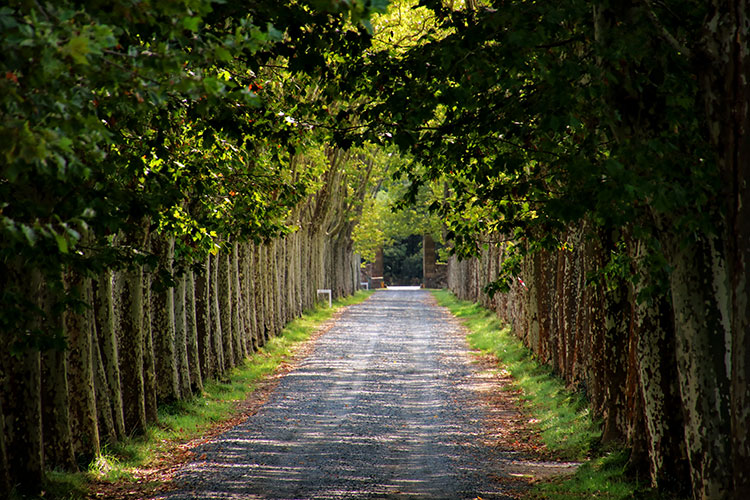
The visit continues with a walk down the tranquil tree-lined carriageway. The plane trees are planted perfectly symmetrically and form a natural vault overhead. The tree-lined carriageway is a historic treasure and part of the Saint James Way, with pilgrims still passing along it to this very day.
Inside the winery, we have a look at the process from grape to Sauternes. The hand-picked grapes arrive at the press during the harvest, then it’s a several hours long process to press the highly concentrated juice out of the grapes that have practically shriveled up in to raisins. The pressed juice is emptied into tanks that are built in to the ground for the ease of keeping the temperature cool, and stays there just overnight to allow any sediment like the bitter seeds to sink to the bottom of the tank. The clear juice is then transferred directly to the oak barrels, where the alcoholic fermentation takes place over 3-4 weeks.
The grapes are pressed and fermented by plot. The very best plots are eventually blended to achieve Château Guiraud’s specific signature blend.
The blended wine ages in oak barrels in the château’s cellar until it’s ready for bottling.
All of this history, the sights of the vines and equipment, and the caramel scents of the barrel room are a dance of anticipation leading up to the moment you finally get to taste. The classic visit ends back at the boutique with a tasting of the estate’s wines.
The Sauternes and Cheese Pairing
Sauternes is a much more versatile wine than one that can just be served with foie gras or dessert, as it often typically is. Château Guiraud’s Sauternes and Cheese tasting helps you to discover excellent pairings while bringing out the aromas and demonstrating how Sauternes changes with age.
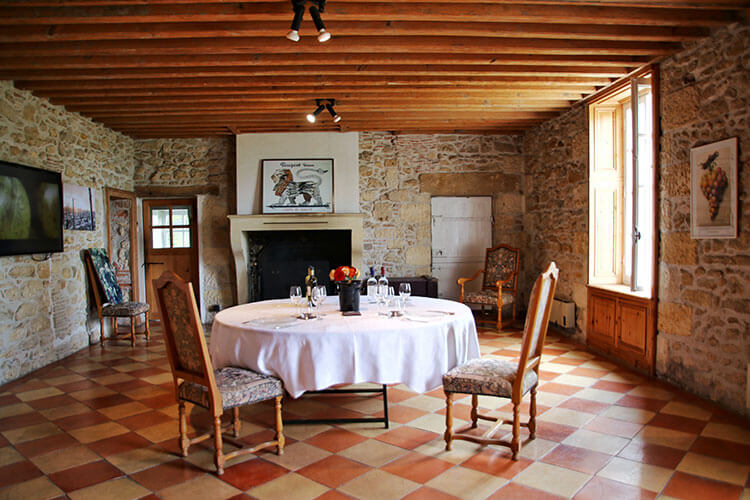
The tasting is a private tasting set in a beautiful room of the château. Cheeses are carefully selected to pair with three Château Guiraud 1855 Premier Cru Classé vintages. We tasted the 2014, 2006 and 1998 vintages along with Comté, Saint-Nectaire and Roquefort cheeses.

When tasting, you always begin with the youngest vintage. Younger Sauternes have notes of pineapple, peaches and apricots. The 2014 was paired with a Comté, an unpasteurized cow’s milk cheese that has brown butter and roasted nut flavors with a sweet, fruity finish.
My personal favorite of the pairings was the 2006 vintage with Saint-Nectaire cheese. The 2006 has flavors of orange marmalade with a nuttiness, which is well complimented by the hint of hazelnut in the soft cow’s milk cheese.
Even though Roquefort is called the cheese of kings and popes, I’ve never really been a fan. I’m not a fan of any blue cheeses. Like I had a life-changing oyster in Cap Ferret that turned me around from oyster hater to oyster lover when I first came to Bordeaux, I now believe that Roquefort and an older Sauternes like the 1998 vintage it was paired with are a match made in heaven.
In fact, many French people eat Roquefort with an equal amount of butter just to take the edge off the tanginess of it. The Sauternes softens the sharpness of it and even sweetens the flavor. I’m forever a convert after this pairing, and if you’ve also always shied away from blue cheeses, I think you will be too.
La Chapelle at Château Guiraud
Opened in the former Protestant chapel of Château Guiraud, La Chapelle is one of about a dozen Maison Lascombes restaurants located around the Gironde department. The menu features dishes from the region and particularly from Gascony, the rural area stretching from the cities of Bordeaux to Toulouse and often described as one of the most delicious parts of France. After all, the cuisine of Gascony is considered to be the pillars of all French cuisine.
Just as we recommend La Brasserie Bordelaise and Le 7 Restaurant Panoramique de La Cité du Vin in Bordeaux, we give our stamp of approval to La Chapelle. We sampled a variety of the dishes, with every single one absolutely exquisite.
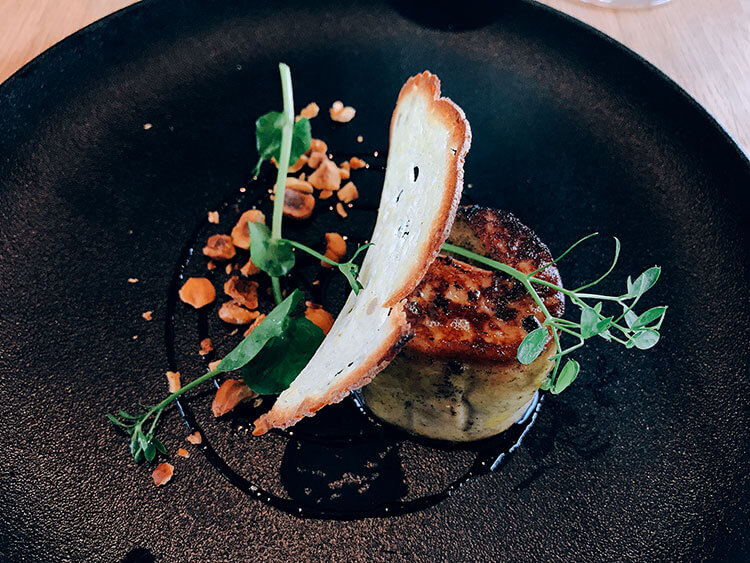
To start, the tomato salad with mozzarella is very fresh with the tomatoes straight from the organic garden. Foie gras is iconic of Gascony and the south west of France, and it’s seared then drizzled with an aged balsamic at La Chapelle. It melts in your mouth.
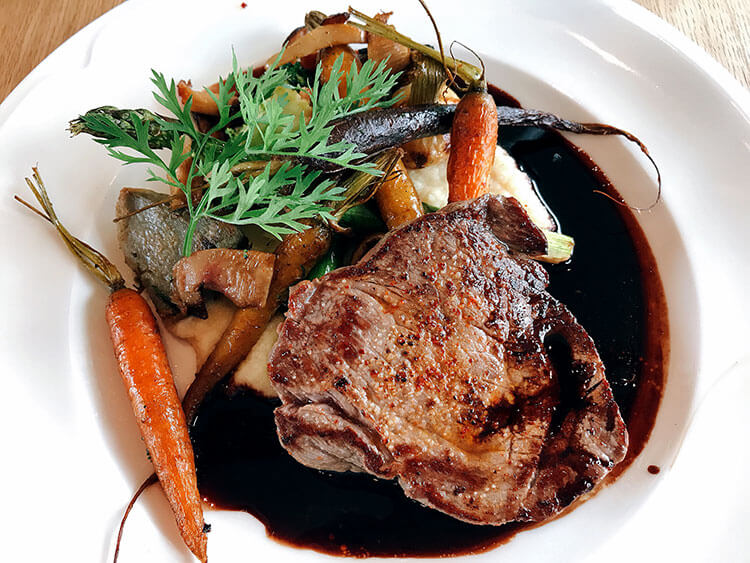
Just like in Gascony, at La Chapelle you find the famous Boeuf de Bazas. It’s beef under an IGP (Indication Géographique Protégée) from a rare, special breed of cow raised under very strict conditions here in the Nouvelle Aquitaine region.
The breed was brought back from the brink of extinction and these days there are still only around 280 farms raising the Bazas-grade beef. You won’t find Boeuf de Bazas in supermarkets and only 13 butchers are certified to sell it, so when you spot it on a menu we highly recommend you try it. The Boeuf de Bazas at La Chapelle comes from the farm of Laurent Groussin and is served with seasonal vegetables from the organic garden of Château Guiraud.
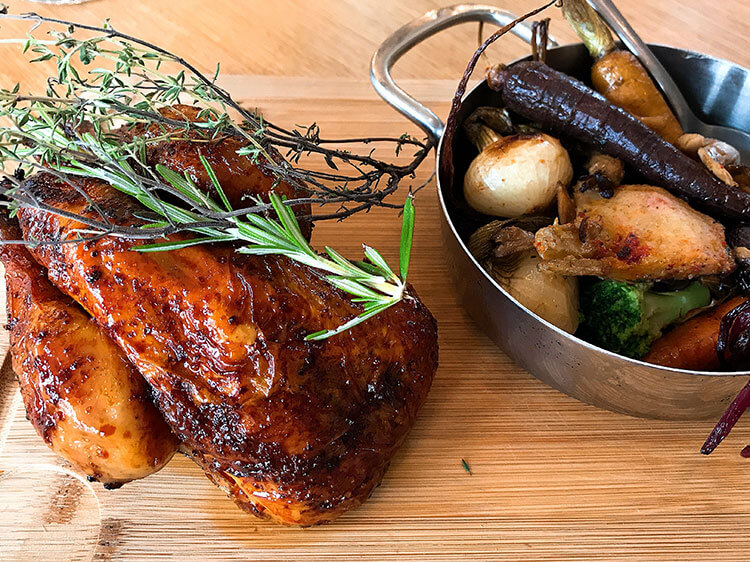
The roast chicken is a whole small chicken from a nearby local farm that is roasted with thyme from the organic garden. It was roasted to perfection – golden, yet juicy.
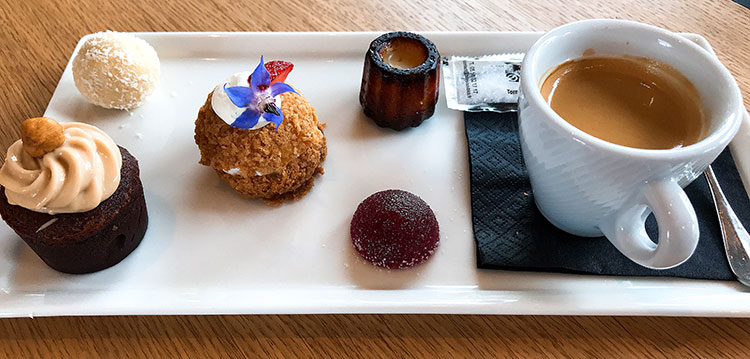
Cafe gourmand is always our favorite dessert since you get to sample several mini desserts. And everything can be enjoyed with wine pairing from the château or other organic wine selections from around the Bordeaux region.
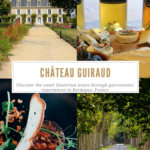
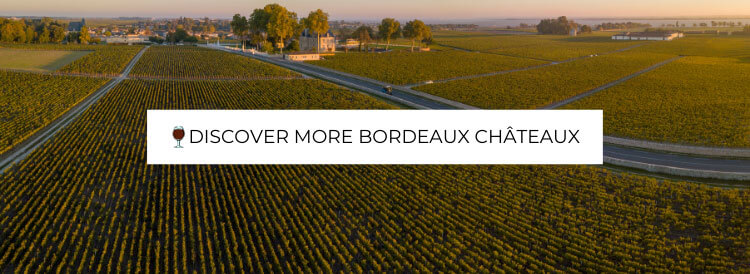
Allison Wallace says
We visited Sauternes for the first time a couple of months ago. Loved the region and visited Suiduraut. We are big fans of Girard and only wish we had the time to have visited there too. Thanks for the inspiration and we’ll be sure to go there on our next visit!
Jill Barth says
I’d love to visit this place, what a wonderful environment. 635 different species of insects — I love that they’ve taken count. Thanks for sharing this!
Robin Bell Renken says
What a fantastic visit! I too am fascinated by the census of species of insects! All that history and such amazing pairings. I have only dabbled in Sauterns, but I have a friend for whom they are the end all! I’m excited to share this with her! I am glad that they changed your opinion of Bleu Cheese!
Greig Santos-Buch says
Omg! We have a 2011 Guiraud Sauternes in the wine cooler right now (have not drank yet been saving for a special occasion). Loooove their forward thinking organic practices and this was an amazing walk through of a place I’ve been planning to visit soon!
Andrew Welch says
I love Sauternes wine, though I’ve not been to the place itself. The experience of reading this has absolutely ruined whatever it is I will find for lunch today (it’s about noon in my time zone), but I’m grateful for you sharing it nonetheless 😉 Cheers!